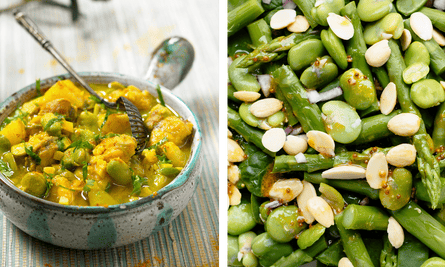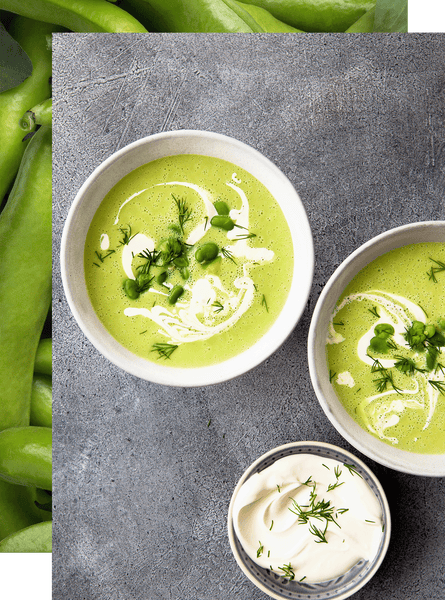Go back in time as far as the iron age, and you’d find our ancestors eating broad beans. For centuries, the legumes were a crucial part of the British diet, until they fell out of fashion. Recently, however, they’ve been cropping up in an increasing number of recipes from some of the country’s most exciting chefs and food influencers.
Gem Morson, AKA the Mother Cooker, is on a mission to help us eat more seasonally. “Broad beans are a fantastic ingredient,” she says. “They’re packed with protein, fibre, vitamins and minerals, plus they’re grown in Britain. And because they’re available when they’re in season, they taste so much better, too.”
The large, flat, bright green beans produced by certain varieties of the vicia faba (fava bean) plant are one of the oldest cultivated crops in the UK. Creamy, nutty, buttery and slightly sweet, they are picked and eaten fresh in late spring, and they’re a vegetable that freezes well too.
As the UK’s largest supermarket, Tesco is helping customers make better choices when they shop by highlighting better foods, such as snacks containing under 100 calories or foods that are high in fibre or low in sugar, through its Better Baskets campaign.

Sales of frozen broad beans have increased by more than 10% in the last year, as customers affected by the cost of living crisis look for ways to make their budgets go further. “At £1.60 for a big bag, they’re affordable, just as nutritious as fresh and very convenient – they cook in five minutes from frozen and there’s no waste because the rest of the bag can be popped back into the freezer,” says James O’Neill, buying manager at Tesco.
The fresh variety, on the other hand, is seen as a “premium” product, and has suffered a slight decline in sales in recent years. “Historically, customers choosing fresh broad beans have tended to be older, as they would have grown up eating more seasonal British produce,” says Lisa Gilbey, buying manager at Tesco.
The retailer is hoping to change that by highlighting the beans’ many benefits. One of which is that they “are great for soils and humans alike”, in the words of Caroline Green, a director at AS Green, the family-run, Malvern-based farming business, which grows them for Tesco. Like other legumes, broad beans have nitrogen-fixing bacteria in their root systems, enriching the soil rather than depleting it.
For Morson, they’re the perfect example of a British-grown vegetable that we often overlook in favour of more exotic options, but which can be used in a wide variety of exciting ways. “They’re great in a fresh, creamy risotto, or blended and made into a lighter version of hummus, or smashed with lemon juice and garlic on toast, with some crumbled feta on top,” she says. “They’re also excellent thrown into soups and stews, adding protein and fibre and making them more hearty and filling.”
She recommends double podding them – removing the pod and also the skin of the individual beans: “Blanch them for two minutes, drain and cool them under cold water and use your nail to slit the skin and pop them out. It takes a little bit of time, but it’s worth it to make them more tender and delicious.”
Nishtha Patel, known as the Gut Expert, is also a fan. A clinical nutritionist who works with clients to tackle disorders including IBS, colitis and autoimmune disease, she is renowned for her tips on how we can optimise our gut health. We’re all increasingly aware of the importance of our microbiome – the ecosystem of microbes that live in our intestines – and Patel says: “With their abundant fibre content, broad beans work wonders for digestive health, promoting the growth of vital friendly gut bacteria.”

Unlike some legumes, broad beans are low in Fodmaps: types of carbohydrates that can be poorly absorbed in the small intestine and fermented by bacteria in the large intestine, leading to bloating, gas, and abdominal pain, particularly in people with IBS. “They are a great choice for those with sensitive stomachs,” she says. “Thanks to their complex carbohydrates, they also provide a steady supply of energy throughout the day, without any dreaded energy crashes.”
Patel often cooks them in stir-fries, serves them simply steamed or uses them in curries, with garlic, cumin and tomatoes. “And I love them as a crispy snack, using fresh or thawed frozen beans tossed with olive oil, garlic powder, paprika, salt and pepper, then baked at 200C for 20 to 25 minutes. They make a delicious and nutritious snack or a crunchy topping for salads or soups,” she says.
Morson hopes the comeback of broad beans will continue apace, with more people rediscovering native-grown vegetables. “Once you realise how much better food tastes when you eat it in season, it’s a gamechanger,” she says.
Find out more about how Tesco is working to improve the health of the nation at tesco.com/better-baskets
Source: theguardian.com


